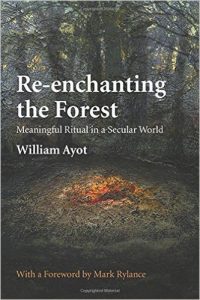 Re-Enchanting the Forest: Meaningful Ritual in a Secular World by William Ayot
Re-Enchanting the Forest: Meaningful Ritual in a Secular World by William Ayot
Reviewed by David Lorimer
Picking up this book, the first thing the reader notices is the fulsome tributes by many leading people from different disciplines, including a foreword by actor Mark Rylance. Read on, and you will certainly not be disappointed by this remarkable account both of the author’s life and the way in which he came into ritual. His childhood was challenging, to say the least. His father died of a heart attack just after a terrible row when Ayot said he could never forgive him. He worked in the gaming industry for 20 years before gradually finding his path, where reconnecting with the village of his childhood was an important step. After this break with his father, he made a pyre of his childhood objects and set it on fire – perhaps a classic example of a ritual of separation.
He defines rituals of three kinds: continuity, alignment and growth, within a context of ceremony and ceremonial objects. Spaces and places are also important in terms of liminality and the sacred. He then sets out the stages of ritual in terms of setting an intention, preparation, opening and invocation, action and expression, closure and grounding. He draws on extensive experience with native elders such as Malidoma Some and it is clear to me that he has tapped an important need in our time when rituals and initiation have all but disappeared except in degraded forms. Readers of Nelson Mandela’s autobiography will remember his initiation and its function. Related to this is pilgrimage, and Ayot describes turning up at St Cross Hospital near Winchester and asking for his Wayfarer’s Dole, which turned out to be a small square of sliced bread with a pottery beaker of ale on a wooden platter.
He gives moving examples of rituals he has conducted with individuals and small groups, showing how this can enable the true expression of feelings and a capacity to move on into a new form of life. Sometimes this involves staying out all night and greeting the sunrise as a symbol of new life. He also describes his own rather harrowing vision quest. He argues that the lack of rituals in our culture leaves us both entangled and bereft, so that the more rituals we create or reinstate, the better our psychospiritual and emotional health (p. 96).
An important place for him is Albion Pond in New England, where his wife Juliet first took him for a proper holiday – it took him some time to slow down and relax into the landscape, but this was profoundly therapeutic and put him in touch with both deeper and more primitive aspects of his nature – it reminded me of Thoreau. We can become more alive by opening up and really paying attention in nature, as he shows with an experience of communicating with a badger. In the public sphere, he comments on the extraordinary phenomenon of the death of Diana Princess of Wales when there was an upwelling of spontaneous grieving rituals, and on the opening ceremony of the London 2012 Olympics and Paralympics, which touched a chord in everyone who witnessed it. He also recounts a moving experience with Rowan Williams, with his capacity for lovingly holding individuals and groups in his benign attention during a poetry reading.
Some of the commentators on the book had also experienced the work of Robert Bly (Iron Man) in the 1990s, which was about what it meant to be a man. The title refers to developing a sense of kinship with nature by creating a relationship through our feeling nature. Those of my generation are now called upon to become elders, but there is no widely available ceremony to mark this fact, even though we badly need ritual elders with a modicum of life wisdom. Ayot’s friend, Jeremy Thres, devised exactly such a powerful ritual for him, which turned out to be an intense experience of death and rebirth. He finds that, in reconciling himself to death, he had rediscovered life. He ends with the resonant words for this stage: life is a shedding, simplicity is best. Maybe it is also significant that I unconsciously sighed so often while reading this potent narrative, feeling that it responded to a longing for a deeper sense of connection also identified in the work of Mircea Eliade in his book Rites and Symbols of Initiation.
